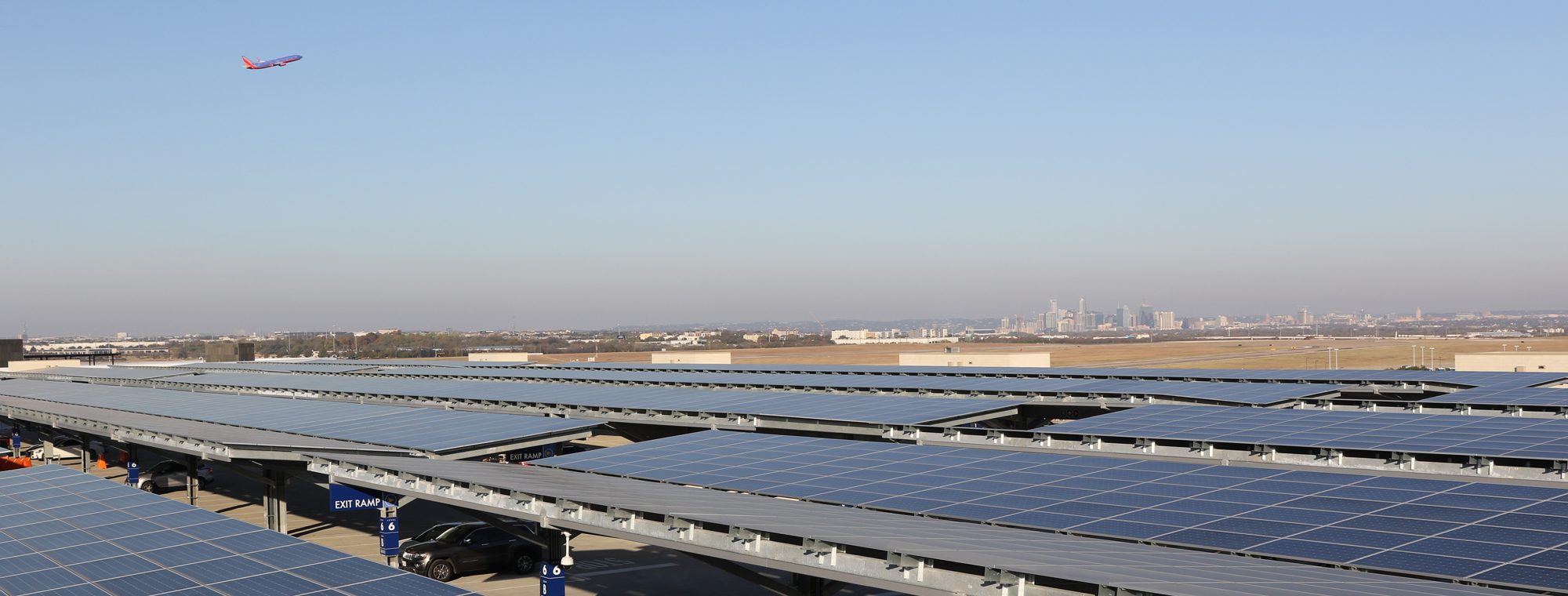
Sustainability from the start
How Austin-Bergstrom International Airport’s legacy of sustainability continues to grow
By BJ Carpenter, Airport Environment and Sustainability Officer | Austin-Bergstrom International Airport
Airports around the country are using innovative methods to incorporate sustainability throughout their operations. Austin-Bergstrom International Airport (AUS) has been reducing its environmental impact by using alternative fuels, reducing electric and water consumption, diverting waste, and building with recycled materials.
Our commitment to sustainability and environmental stewardship began with the airport’s construction. Opened 25 years ago, AUS was the first commercial airport constructed under the Federal Base Realignment and Closure Commission. The city converted a closed air base into a new, international airport. The reuse of materials was a major consideration throughout construction. The terminal was built from 100% recycled steel, and more than 35,000 tons of concrete from the base were crushed and reused for roadways and taxiways.
The base command building was converted into a Hilton hotel, which received the national Green Seal “Silver Level Achievement for Environmental Operational Commitment” for its efforts to reduce its overall carbon footprint, making it one of only five hotel properties in Texas to earn this distinction.
In the years since AUS’s opening, we have doubled down on our commitment to sustainability, investing time and funding to incorporate environmental initiatives into our operations.
Our Approach to Sustainability
At AUS, the Environmental Affairs Division is empowered to build on the airport’s legacy of sustainability and help plan for future growth. The Division currently has 13 full-time positions, with more coming, in five different focus areas.
- Compliance: Our highly effective compliance team ensures that AUS meets and often exceeds our local, state and federal requirements. This includes coordinating with many onsite stakeholders through permitting, inspections and support.
- Sustainability: This team works to embed our AUS sustainable philosophy throughout development and operations, including our sustainable development goals. This group also handles all of our carbon footprint calculations, manages our waste and additive diversion programs, and tracks our waste production and utility use.
- Infrastructure: This group manages and monitors projects and systems like our vehicle electrification, solar power, reclaimed water, grease traps, and fuel storage.
- Green Building: AUS has a long history of green building. We have multiple LEED silver- and gold-certified buildings and have recently transitioned to the Austin Energy Green Building program, achieving 3-star certification for our Airport Career Development Center. We have two full-time positions in coordination with Austin Energy to further this effort.
- Planning and Remediation: This team oversees activities such as coordination with the FAA, Department of Defense, NEPA compliance, brownfield remediation and other regulatory matters.
An Impact Across AUS
The Environmental Affairs Division has an “everywhere” approach to sustainability. Our division engages with every other division within the Aviation Department from maintenance to finance, as well as over 130 onsite tenants to ensure compliance, implement sustainability initiatives, build greener infrastructure and reduce our carbon footprint. Coordination and collaboration are key to everything the Environmental Division does at AUS.
We focus on educating all new team members—regardless of their position—on our sustainable programs, philosophy and compliance obligations. Every employee can help further these efforts in one way or another, from recycling, to turning off lights or reporting spills and leaks. We want to show them how their daily duties can contribute to making the airport more sustainable and accomplishing the overall goals of the City of Austin.
AUS has been growing at a phenomenal rate and is set to spend billions over the next 10 years with the Airport Expansion and Development Program (AEDP). The Program includes large-scale infrastructure projects like new midfield taxiways, major utility improvements, new buildings — including a new central utility plant, a second concourse, new parking facilities, and a new arrivals and departures hall. This level of expansion has led to the creation of the AEDP Sustainability Goals. These goals were developed over a year and a half by benchmarking many other airports and with extensive input from internal and external stakeholders, including other city departments, industry experts and top consultants from around the world. The goals cover a wide range of focus areas, including energy and water conservation, carbon neutrality, waste diversion, resiliency and adaptability, as well as passenger experience and community trust. As expansion work proceeds, each project will be evaluated based on these focus areas and we will work with our partners to implement targets and metrics to achieve these goals from the pre-planning stages through operations.
Next Level Sustainability
While sustainability has always been a focus at AUS, our program came further into focus in 2016, when we decided to join the Airports Council International-North America Airport Carbon Accreditation program. As we’ve progressed through the program to higher levels of accreditation, we’ve mapped our footprint, showed carbon reductions each year, developed a stakeholder engagement plan and are continually working to reduce the remaining carbon footprint. In 2021, Austin became the first medium-hub airport in North America to reach Level 3+ Neutrality accreditation and we continue to offset 100% of our remaining carbon footprint.
Our work is not done. We’re aiming to reach a Level 4-transformation rating this year and this is no small task. It will require a comprehensive analysis of our emissions, as well as close collaboration with our stakeholders and a laser focus on actively delivering emissions reductions. We are defining a long-term management strategy focused on achieving absolute emissions reductions that align with the objectives of the Paris Agreement.
Setting Our Goals
To keep us accountable, AUS released our first-ever Environmental, Social and Governance Report. It provides an overview of our how our environmental stewardship, operations and customer service work together while we connect Austin and Central Texas to the world.
On the environmental front, the report covers, among other goals:
- Climate resilience and adaptation
- Energy consumption and greenhouse gas emissions
- Water use and resources
- Waste and recycling management
- Procurement and resource management
- Wildlife protection and biodiversity
- Extreme weather risks and responses
From the very beginning, AUS has had a strong focus on the environment and sustainability. Now with a massive expansion program kicking off, aiming to double the capacity of the airport with the construction of Terminal B, we continue to focus on making AUS one of the most sustainable airports in the world. We have an incredible group of dedicated employees within the Aviation Department, and great support from our sister departments and leaders. I look forward to seeing what we can all accomplish together! Austin is one of the greatest cities in the country, and we want to play a role in keeping it that way.
ABOUT THE AUTHOR
 BJ Carpenter
BJ Carpenter
Environment and Sustainability Officer
Austin-Bergstrom International Airport
BJ Carpenter is the Environment and Sustainability Officer at Austin-Bergstrom International Airport, helping to incorporate sustainable principles, climate resiliency best practices, and environmental stewardship into all aspects of its culture, planning, development and operations at AUS.
